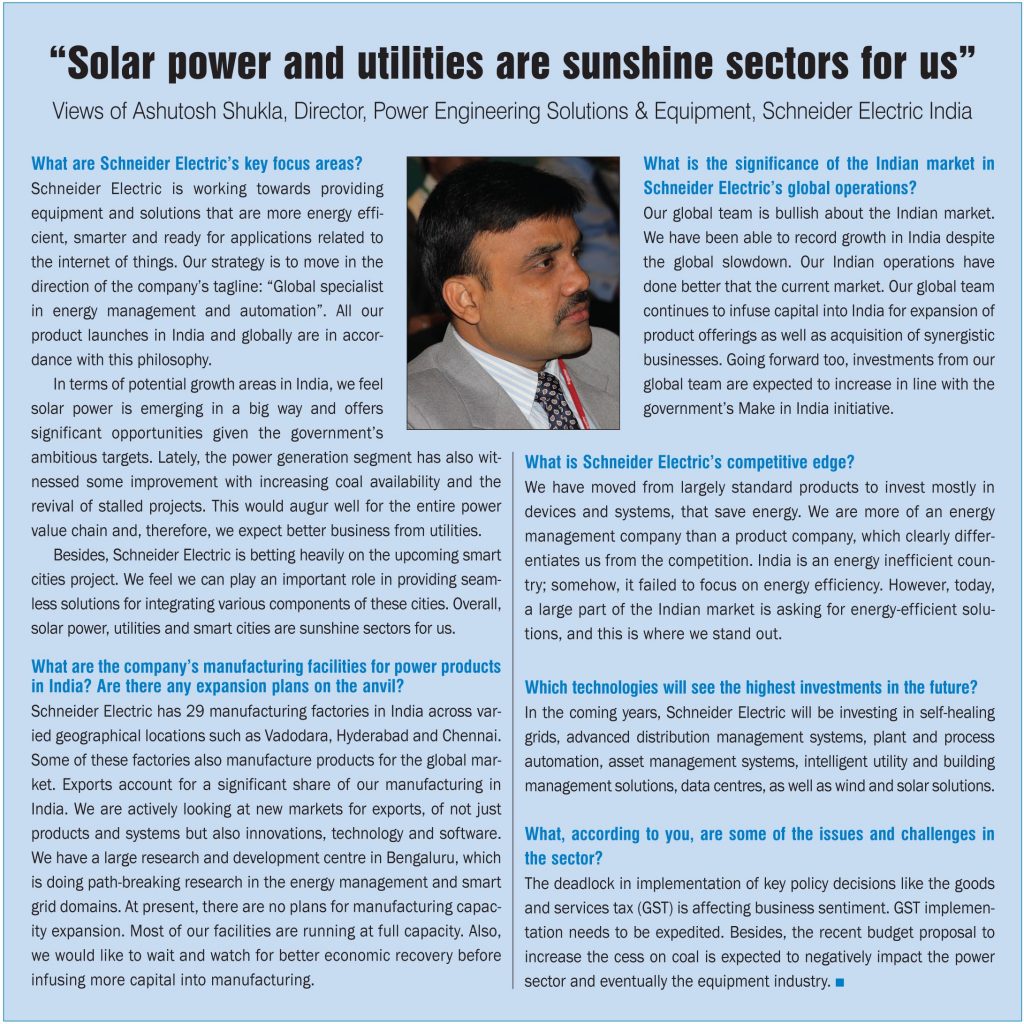
Schneider Electric, the France-headquartered multinational conglomerate that commenced operations in the iron and steel industry in 1836, has today evolved into a global energy management and automation specialist. The company entered the Indian market in 1963 as a joint venture with Tata Sons and Voltas. In 1995, a 100 per cent subsidiary of the company was incorporated, following which Schneider Electric has grown by leaps and bounds in the country. Today, the company has emerged as a leading provider of equipment and automation solutions for the Indian power sector, especially distribution.
Product portfolio
Schneider Electric’s product portfolio encompasses a wide variety of equipment and solutions across segments such as electrical distribution, installation systems, automation and control, building management and security, critical power and cooling services, smart grid, and solar.
The company’s range of products for the power distribution segment includes circuit breakers, switches, meters, enclosures, relays and switchboards, feeder automation, medium voltage transformers, substation automation systems, power monitoring systems, and digital control systems. In the solar segment, Schneider Electric provides a range of backup solutions, compact substations, grid monitoring and control systems, and protection systems for off-grid, ground-mounted and rooftop plants.
The company has 29 manufacturing facilities spread across the country at locations such as Vadodara (Gujarat), Nashik (Maharashtra), Chennai (Tamil Nadu) and Hyderabad (Telangana). Many of these facilities cater to both the domestic and international markets.
Medium voltage power business highlights
Schneider Electric has a large client base comprising almost all state power utilities. The company is executing solutions under the Restructured Accelerated Power Development and Reforms Programme (R-APDRP) as well as smart grid pilot projects. Overall, it witnessed a flat growth in order inflows in 2015-16 vis-à-vis the previous year, yet it performed better than the market.
In the past year, the company implemented supervisory control and data acquisition (SCADA)/distribution management system (DMS) solutions for KSEB Limited, covering the cities of Thiruvananthapuram, Ernakulum and Kozhikode. It also completed automated DMS in Puri for the Central Electricity Supply Utility of Odisha.
Further, the company set up a containerised substation for Odisha Power Transmission Corporation Limited. The substation requires less space than conventional air-insulated switchgear substations, and is mobile, completely unmanned and equipped with digital tools to transfer data to the control centre.
In April 2015, Schneider Electric signed an agreement with Essel Infraprojects Limited (EIL) to develop smart city projects in India. The company has executed over 250 smart city projects globally, including in Hong Kong, Carson City, Barcelona and Lyon.
Mergers and acquisitions
Schneider Electric has made a spate of successful mergers and acquisitions (M&As), which have contributed to its expansion in the Indian market and globally. Schneider Electric’s most recent big-ticket global acquisition was that of industrial automation company Invensys, in January 2014. Invensys already has a significant presence in India. Other major acquisitions by the company include Luminous (2011), AREVA T&D (2010) and Conzerv (2009).
Opportunities and threats
Schneider Electric is upbeat about the opportunities in the smart grid and renewable energy space in India. The company is trying to bring in more innovative and efficient solutions for power utilities to help them extract the maximum from their existing assets. The current precarious financial condition of discoms is due to inefficiency, which its products can help overcome.
For instance, the company is developing reliability-centric asset management systems with predictive fault detection mechanisms. This would enable utilities to save on capex for fault restoration as well as revenue due to the loss of power.
In the renewable energy space, the company is investing in solutions that help in the integration of infirm power in the grid. For example, the company is developing transformers to integrate power from rooftop solar plants with the distribution grid that regulates voltage fluctuations on cloudy days or days when sunshine is not adequate.
Further, Schneider expects to launch advanced metering infrastructure (AMI) as well as demand response solutions. Besides, it is exploring opportunities in the area of rural electrification through the development of microgrids.
However, the presence of multiple project coordinating agencies and a non-uniform bidding process by utilities are some areas of concern for the company. The bidding process followed by utilities should be more stringent and should focus on the technological competence of bidders. Also, utilities should implement several pilot projects to find the best technology that fits their requirements. Besides, the issue of inadequate investments in the transmission and distribution segment vis-à-vis generation needs to be addressed to create more opportunities for equipment and solution providers

